|
Whenever I look at articles
like this one in American Aircraft Modeler magazine of the 1967 model rocketry
nationals (NARAM-9) showing people from 40+ years ago, I always wonder what they
are doing today. Kids that were 16 in 1967 are 60 today! Many of the adults, if
they are still living, are in their 80s. Are they still flying model rockets? Are
they in good health? Has life been good to them? Time can be a cruel master, or
it can also be a benevolent guardian. But, at the time nobody was thinking about
where they would be or what they would be doing in the year 2011; their only concern
was the competition at hand and having a good time. Note the number of Ph.Ds in
the crowd! Back in the day, model rocketry was a big part of preparing young men
(and a few young women) for a career in astronautics. In 1967, model rocket kits
were selling for a couple bucks apiece, and the high-end models like the Saturn
1B and the Mercury-Redstone sold for close to $10. If you try to buy one of those
models on eBay today, you will have to shell out, in some cases, $200-$500 (or sometimes
more).
Update 11-6-2011:
Every once in a while I'll get a surprising letter from somebody that found himself/herself
or somebody he/she knows in one of the old articles that I publish on the Airplanes
and Rockets website. I always ask for permission to reprint all or parts of
the letters on the associated page. This time, it was
Mr. Doug Ball, who,
with NAR membership number 9338, has been involved with model rocketry for quite
a while. Doug is now an engineer at Boeing. Read his letter that answers the question
I posed above.
"Kirt, on your website you ask about where some of those young rocket modelers
are 40+ years later. Well, in that article written by
G. Harry Stine,
there is a picture of a young man named
Charles Duelfer.
'Charlie' was on the cover of Time Magazine - he was the author of the Iraqi weapons
report that basically said they did not have WMD's.
Jay Apt, a founder of the
Pittsburgh Spring Model Rocket Convention, went on to become an astronaut and fly
4 shuttle missions. He is also an astrophysicist. Matt Steele is an executive at
ATK. He builds big ones for real.
Craig Streett
and Robert Biedron
are renowned researchers at NASA Langley.
George Pantalos
is a developer of artificial hearts at the University of Louisville,
John Langford founded Aurora
Flight Sciences - a very successful aerospace company today.
Jerry Gregorek celebrated his
80th birthday this year - officially retired four years ago from teaching aeronautical
engineering at Ohio State but still teaches their senior design class.
Chuck Hall is now a professor
of aerospace engineering at North Carolina State University. The young lady in the
article, Connie Stine,
is now my wife. Connie went on to become a very successful ballerina, owning her
own school in Mesa, Arizona, for 22 years. Her sister, Ellie, is an accomplished
equestrian instructor and national judge. Connie's husband, Doug, is now the chief
of aerodynamics for Boeing Commercial Airplanes. The hobby, and those adults back
then who recognized its educational value, gave many of us the most amazing, rewarding
and exciting careers one could ever imagine. To them, and especially to Harry, we
owe a debt of gratitude. And so we try to stay true to Harry's motto 'Pay Forward.'
It is our turn to mentor and encourage the next generations of aerospace engineers
who will take us not just from continent to continent, but back to the moon and
then the stars. It's as inevitable as the tides."
Milestone in Mankato: Ninth Rocketry Nats
In mid-August the nation's finest rocketeers assembled for NARAM-9. An
eyewitness account
G. Harry Stine
photography by the author
The Ninth National Model Rocket Championships (NARAM-9) sanctioned by the NAR
at Mankato State College, Mankato, Minn. was one for the books - technically, competitively,
organizationally.
Contest Director Dr. Ellsworth B. Beetch, Professor of Chemistry at Mankato State,
got the full support of the college and used the NAR Zenith Section to provide range
equipment and management manpower. NAR Contest Board Chairman Al Kirchner selected
the 74 invited contestants from all over the United States. Old-timer Manning Butterworth
was in charge of the range set-up on the Mankato Airport; the rangehead was right
at the intersection of the two active runways of the field. This might have caused
some problems, since the field was not closed to air traffic, had it not been for
the constant vigilance of Chief Safety Officer John Belkewitch and his eagle-eyed
assistants. Leader Member Jack Higgins deftly handled scale judging while NASAman
Bob Atwood took care of R&D judging. Pinky Guill ran the data reduction quickie-boards,
working from tracking data supplied by Dr. William Perendy and his tracking crews.
The meet got under way on Tuesday, August 15th, with the first model - a Parachute
Duration - launched by NASA Astronaut Thomas K. Mattingly. A certain amount of wind
and a lack of good thermals denied good record-breaking Parachute Duration performance.
In general, the PD models showed no new technological achievement, but there is
a tendency to go to large-diameter bodies to hold the large chutes easier, and the
winning chute models did not have very large canopies. Pat Artis, however, had a
beautiful 30-inch chute made from rip-stop nylon that can be used without wadding
and is practically indestructible. Engineers from Scheldahl watched this event with
great interest; they make big chutes for the big stuff. Winning times were not high.
Charles Gordon of Laurel, won Junior Division with 3: 57. Leader Division blue
ribbon went to Victor Ceicys of Parma, Ohio with 7:39, while Senior Division was
copped by Gerry M. Grekorek, from the Department of Aeronautics and Astronautics
at Ohio State University.
In Swift Class Boost-glider Duration, most of the birds were designed well. Tech
transfer between BIG and hand-launched gliders was evident with some hi-point airfoils
being used and vortex tips on a couple of designs. The Juniors and Leaders turned
in better performances than the Seniors. Sam Atwood, Annapolis, Md. won Junior with
3:02 and Raymond Forbes, Ft. Riley, Kans., turned in a winning 3:26 for Leader Division.
The husband-wife team of Jim and Judy Barrowman (he's a rocketsonde expert from
NASA Goddard Space Flight Center) won Senior Division with 1: 26.
Wednesday, August 16th, was hot and sunny. PeeWee Payload got off with a roar.
Some people had Payload birds that would really perform, but they were so hot that
the trackers couldn't stay with them. Had these hot birds not suffered "track lost,"
we would have had higher winning altitudes than we did. The boys that won had large,
slow-moving birds that could be tracked. For the first time, the event was pretty
well mixed between the use of Estes engines and the new Flight Systems engine; 630
feet brought the Junior blue ribbon to Mike Poss of Huntington Beach, Calif. Joe
Persio, Cheshire, Conn. was tracked to 540 feet for Leader Division first place.
Your reporter took first place in Senior Division flying Talley Guill's Dubnica
Payloader design (Count Down, September 1967) single-staged with a B3-5 engine;
it went to 750 feet, which is right in the ball park of performance for this design.

In mid-August the nation's finest rocketeers assembled for NARAM-9.

New NAR President Dr. Ellsworth Beetch and son Konr preparing
a Swift Class boost glider. (Plans for similar model, Aug. '67 A.M.)

Dr. William Perendy with highly successful device used at 1967
NARAM-9 for calculating the peak altitude of a model flight.

The spot landing event in the rain turned out to be fun anyway.
Measurement crew checks landing distance of a flight.
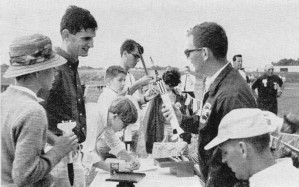
"But sir, it flew O.K. last week!" Rocket C.P.-method expert
Jim Barrowman checks Talley Guill's plastic Mercury-Redstone.

1967 Junior Champion Charles Dueller checks the igniter in his
scale I.R.I.S. bird amid the competition.
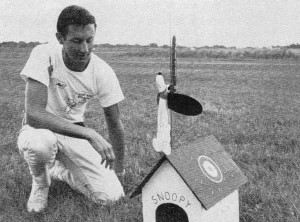
"Well chaps, time for another important mission. But I dare say
they are all important, eh what?" In the crisp morning air near the aerodrome at
Manquateaux, faithful ground crewman Mike Poss stands by to assist the takeoff of
Mr. Countdown himself.

The beauty of scale! Al Kirchner with his "Little Joe II" comparing
models with Estes' "Saturn 1B" held by Jaroslav Broz.
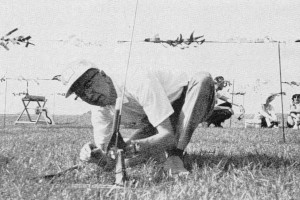
Orville H. Carlisle, NAR's first, and #1, member, preparing to
launch one of his original 1957 model rockets. Is he flying in a mythical old-timer's
event for antique models? Flies well.
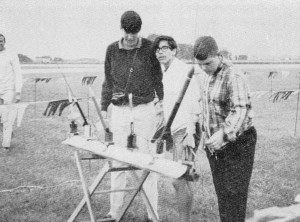
Separate target poles for spot landing event results in launch
rails being cocked at all angles. Which way to duck the birds?
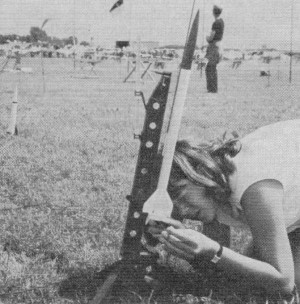
Connie Stine preparing her I.Q.S.Y. Tomahawk for its Aerospace
Systems flight. She was the only girl entrant at NARAM-9.
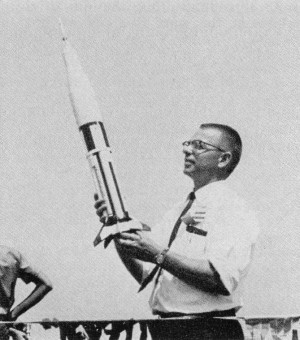
Vern Estes with "Saturn IB" from his new kit. Model uses cluster
of four engines.
Class 1 Scale Altitude was dominated by simple, well-proven scale models. Johnny
Drake, New Canaan, Conn. hit 730 feet with an I.Q.S.Y.-Tomahawk (Count Down, October
1967) built with an Estes BT-20 tube. A Tomahawk also brought second place in Junior
Division to Connie Stine, the only girl contestant at NARAM-9. In Leader Division,
Old Champ Talley Guill flew a beautiful IRIS (with booster) to 465 feet to win with
a total of 1319 points. His father, A. W. "Pinky" Guill, took first in Senior Division
with an Astrobee-1500.
A certain amount of trouble was experienced by contestants who had not thoroughly
read the rules or done sufficient research on their scale models. NAR rules say
that the top stage of a multi-staged vehicle cannot be flown in scale events without
operable lower stages unless it can be proven by the contestant that he modeled
an upper stage that actually flew by itself without a booster. Again, I will say
it, and can speak with some authority as a consultant on launch vehicles for the
Smithsonian: (a) no WAC-Corporal ever flew without its Tiny Tim booster; it was
designed to fly with this booster; (b) according to Atlantic Research Corporation,
no IRIS ever flew without its booster, and it was designed to fly with a booster;
(c) only one Aerobee ever flew without its booster; Aerobee A-10, an RTV-N-8 model,
took off unexpectedly from the launch tower on the U.S.S. Norton Sound on March
17, 1949 as a result of a leaky valve, leaving its booster behind in the tower.
And the booster must be operable; it cannot be a dummy that has been deliberately
intended to be destroyed on the launch rail by the jet of the sustainer.
On Thursday, the Aerospace Systems event was flown for the last time. In the
new rule book now in effect, it has been changed completely into the Space Systems
event. Charley Duelfer, Stamford, Conn. hit the jackpot in Junior Division after
trying hard at four previous NARAMs; he won with his breech-launched ARCAS model.
In Leader Division, it was Talley Guill and his old, reliable Convair MX-774. Yours
Truly took the Senior Division with an I.Q.S.Y.-Tomahawk powered by an FSI D-1.15-6.
Some beautiful scale models completely worthy of the title showed up for the
Scale event. Steve Glines of New Canaan, Conn. took his first NARAM trophy with
his Astrobee-1500 model. Again, Talley Guill's MX-774 took a winner's trophy in
Leader Division; after building that bird for 5 years, Talley's getting very good
with it. The same can be said for his father's Astrobee-1500 which took Senior first
place. Some of the other notable scale birds were Jim Barrowman's excellent Nike-Tomahawk
(Jim works on that bird at NASA Goddard), Johnny Drake's Shotput, Greg Scinto's
big IRIS (with booster), and Dick Sternbach's Titan.
Plastic Scale became "plastic model" event this year with the elimination of
requirements to prove scale qualities. It did not degrade the event in any way.
It is tough to find a non-flying plastic model kit that can be converted into a
good flying model, but the boys are doing a good job at it. True, there were some
flops, which is to be expected. But the ones that went were great and showed meticulous
craftsmanship that might be the envy of the International Plastic Model Society.
In Junior Division, it was Johnny Drake of New Canaan, Conn. with his NASA X-15,
a most difficult bird to get to fly properly. And it was an X-15 from the Revell
kit that won Senior Division for the new NAR President Dr. Ellsworth Beetch and
his son Konr; Al Beetch, being a professor of chemistry, knew just exactly what
kind of paint to use on polystyrene plastics, and his X-15 had a perfect mirror
finish. In this event, there were plenty of Hawk Jupiter-C kits modified for flight,
a combination Hawk Jupiter-C and Revell Mercury capsule to produce a Mercury-Redstone
by Talley Guill, numerous Revell Atlas-B's, an Aurora Regulus-II, and some Revell
Thor's. The lure of this event seems to lie in several areas: finding the kit in
the first place, modifying it to fly, and getting it to fly.
The Research and Development event this year was, to me, somewhat disappointing
in the Junior and Leader age divisions. Most of the research and development might
have been interesting and educational, but it wasn't practical. For example: (a)
retro-rockets for soft landings may be interesting, but they would cause fire marshals
to shudder; (b) water injection to improve performance requires so much additional
weight that it offsets any possible performance gains; and (c) front-engined finless
rockets were thoroughly investigated and discarded by Dr. Goddard and the old American
Rocket Society back in the 1930's. However, in the Senior Division, some excellent
work was in evidence that shows the beginnings of a trend predicted in "Count Down"
some time ago: the aerospace professionals who have taken up model rocketry as a
hobby are starting to apply professional techniques to the hobby in a way that the
young rocketeers can understand and use. Doug Malewicki extended the graphs and
charts of his Estes TR-10 to include the Flight Systems and Centuri engines. Dr.
William Perendy came up with a new and improved tracking theodolite. Both Jim Barrowman
and myself entered simplified methods of calculating the center of pressure of a
model rocket. Gerry Gregorek of Ohio State used his department's computer to work
on drag calculations of models, drag reduction, and altitude determination. Bernard
Biales, of course, has been a BIG fan for years and has done a lot of work in that
area.
A number of excellent demonstration flights on Thursday should be mentioned because
they are indicative of the progress in model rocketry. Leroy Piester of Centuri
boosted aloft some of his models powered by the Mini-Max Class E and Class F engines
... and they move out! Vern Estes launched his new super-scale Saturn 1b powered
by a cluster of four engines and recovered by two chutes on the booster and a single
separate chute on the Apollo capsule; this bird flew beautifully twice and looks
like the real thing when it goes up ... but it is not for beginners! Irv Wait of
Rocket Development Corporation flew some models powered by his new Enerjet Class
E engine with its variable time delay assembly (you can choose the time delay you
want before flight) ; the Enerjets use a modern composite solid propellant with
a specific impulse of 182 and leave no visible jet or smoke trail . . . just WHOOM!
Irv also flew a real rocketsonde, the RDC "Honeybee" which he is making for the
Air Force; it is a big model rocket powered by an Enerjet with 99 Newton-seconds
total impulse and carrying 0.75 pounds of payload to about one kilometer altitude
with full parachute recovery.
The most spectacular flight of the demonstration was pulled off by George Roos
of Flight Systems who launched his OSO kit model with an FSI Type F18-0 booster
and an FSI Type F1.3-18 sustainer - a short-duration high-thrust booster coupled
to a stop-stage sustainer that burns for 10 seconds; the bird went out of sight
with the top stage still under thrust, the trackers locked up at 90-degrees elevation,
and the bird must have hit over 8,000 feet. These large engines are very powerful,
very expensive, and meant only for the advanced model rocketeer who has plenty of
room to fly in, but they are needed because they provide the means to do the kind
of advanced work the older model rocketeers want to do.
Friday, August 18th, the final day of NARAM-9, dawned cold and rainy ... real
Dubnica weather. And Jaroslav Broz from Prague, our Czechoslovakian guest courtesy
Vern Estes, remarked on this. But the moment the rain stopped at about 9:30, the
Spot Landing event got under way. Juniors, Leaders, and Seniors had different target
poles, which made the adjustable launch rails look like a mass of crossed swords
as contestants strove to compensate for wind and target location. Bernard Biales
of Madison, Wis. dropped his bird in to beat all the Seniors, and Scott Upton, 18,
of St. Louis stood near the Leader pole beckoning his spot lander in to win, nearly
becoming a member of the Royal Order of Pole Hangers. In the Junior Division, it
was Thomas Glass, 14, of Baltimore who got the closest to the pole.
By the time Hawk Boost-glider Duration rolled around, the wind was still blowing
and the overcast hung above our heads. This more powerful class of B/G is somewhat
of a challenge to modelers, and there were a number of "strip tease" flights wherein
the stress of launch caused the wings to part company with the model. However, Bernie
Biales got off a good winning Senior Division flight of 1:59 using an elliptical-winged
B/G with very low wing loading and large area, proving that windy weather does not
automatically require gliders of high wing loading. There were a number of "red
barons," so-called because sometimes a strip pod fails to separate and the model
comes spiraling in with the streamer fluttering out behind, looking like a trail
of fiery smoke issuing from behind a vanquished Sopwith Camel. Ray Stamford, 19,
of Rock Island, Ill. took the Leader Division while Kevin Stumpe, 15, of St. Ansgar,
Iowa, walked away with Junior.
And that about wrapped up the meet except for some demonstration flights. Dr.
Al Beetch had run off a full-scale NARAM on an active airport with planes operating
on all sides of us at all times. The FAA men from Minneapolis had visited us early
in the meet and satisfied themselves that we were doing a safe job. We'd also had
visits from representatives of the National Safety Council, an organization that
had, up until then, looked askance at model rocketry. They were there because the
day before the meet opened, the American Institute of Aeronautics and Astronautics
in New York reversed their decade-old policy of discouraging all forms of non-professional
rocketry to recognize and endorse model rocketry, a tremendous breakthrough.
Our guests on the range during the final day included Leister Graffis, President
of Bendix Field Engineering Company who had flown from Baltimore to see the meet
and present the Bendix Trophies for excellence to the national champs. Also on hand
was R. V. Mrozinski of the National Aeronautics and Space Council.
For the first time we held an awards luncheon; Jim Kukowski MC'ed. As he started
to hand out awards, all doors to the room suddenly had intense, dapper men standing
beside them ... the Secret Service. And Dr, Beetch walked in with Vice President
Humphrey!
The Vice President, as Chairman of the National Aeronautics and Space Council,
was visibly impressed by the model rockets on display in the room, and he graced
us all with a short speech. "The world needs talent, your kind of talent," he told
the young rocketeers. He went on to remark that they were all making an important
contribution to their educations through model rocketry and urged them to get a
college education. He then personally handed out the Bendix Trophies, assisted by
Bendix President Graffis.
After trying five years, Charles Duelfer, 16, of Stamford, Conn. won the coveted
Junior National Championship. The runner-up was William Bloch of Pittsburgh. J.
Tally Guill, 18, of New Canaan, Conn. became Leader National Champion for the third
year in a row (and this was preceded by the 1964 Junior National Championship and
participation in the First Internationals at Dubnica) with Joseph Persio, 18, of
Che-shire, Conn. as runner-up. Yours Truly became Senior National Champion in a
closely-run race with Karl Feldman of South Bergen, N. J. And Fairchester Section,
Stamford, Conn. took the Champ Section pennant for the 4th year in a row!
The Trustees Outstanding Service Award went to Dr. William B. Rich, NAR's hard-working
Treasurer and former Secretary-Treasurer, who really deserves it. The Sportsmanship
Award went by acclamation to Al Kirchner, Jr., last year's Junior Na-tional Champion,
who gave up competition this year in order to handle NARAM-9 contest paperwork and
represent his father who is Chairman of the Contest Board.
Junior competition has always been rough because of the predominance of Junior
members in NAR, and Leader division competition is getting that way as more and
more model rocketeers who have gone to college keep up their model rocketry. There's
a great cadre of Senior competitors now - Pinky Guill, John Belkwitch, Doug Malewicki,
Jim Barrowman, Bob Atwood, Al Beetch, Bernie Biales, Les Butterworth, Karl Feldman,
Gerry Gregorek, and Tommy Thompson. In addition to being top modelers, most of these
men now sit on the new NAR Board of Trustees, giving us the most active Board we've
ever had.
NARAM-9 is now a fond memory.
Here is more coverage of the event in the June 1969 edition of
Model Rocketry.
Posted August 27, 2011
|



